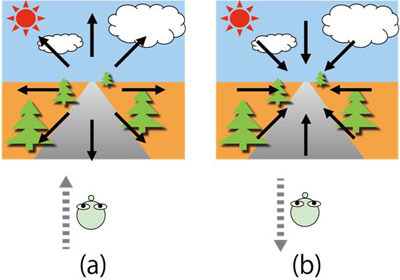Before Crawling and Walking, Babies Need to Get the Visual Gist of Moving Forward
Infants show developmental changes in visual motion perception about one month before they first start moving around on their own, according to new research published in Psychological Science.

(a) Radial expansion flow with forward movement; (b) Contraction flow with backward movement.
Psychology researcher Nobu Shirai at Niigata University and colleague Tomoko Imura at Niigata University of International and Information Studies tested a total 106 young babies who were or were not able to do voluntary locomotion, defined as any of creeping, crawling, and walking with or without holding onto some sort of support.
The researchers displayed several visual motion patterns on a computer screen, such as radial expansion and contraction, and gauged infants’ visual preferences by measuring how long they spent looking at a particular visual pattern.
“Radial expansion flow and contraction flow are visual patterns that approximate the kind of scenes we see when we move forward and backward, respectively,” says Shirai.
“We usually use these patterns to recognize and control the direction of our own movement in daily life. Thus, we expected that there would be substantial interaction between the development in visual motion perception and locomotor action.”
The researchers found that babies who were already moving around on their own spent less time looking at contraction flow than the babies who weren’t moving around yet, while both groups of babies spent a lot of time looking at expansion flow.
In a second study, the researchers followed 20 babies over time, testing their perception and visual preferences every month. The findings showed that babies’ preference for contraction flow seemed to decrease about one month before they started moving around on their own.
“If infants have stronger preference for expansion flow, they may be more motivated to drive valid motor actions that lead to forward movement, leading to the experience of expansion flow and further reinforcing the development of voluntary locomotion,” Shirai concludes.
“This is a new perspective for expanding our knowledge about infant development,” says Shirai. The dominant view has been that experiences of motor action lead to the development of visuomotor coordination but these new findings suggest that developmental changes in visual perception may serve as an important causal factor.
The researchers believe their findings may help to explain reported delays of locomotor development associated with the use of baby walkers.
“Using baby walkers may selectively increase particular motor actions valid for generating forward locomotion (and thus expansion flow) with baby walkers, and then infants would be “satisfied” with the experience of forward motion (and expansion flow) with walkers. As a result, they would no longer be motivated to attempt typical locomotor actions, such as creeping or crawling,” the researchers write.
These findings help to shed light on extensive individual difference in development of locomotor actions in infancy, and may be useful in the development of interventions for atypical locomotor development in young children.
Shirai, N., & Imura, T. (2013). Looking away before moving forward: Changes in optic-flow perception precede locomotor development. Psychological Science. DOI: 10.1177/0956797613510723





APS regularly opens certain online articles for discussion on our website. Effective February 2021, you must be a logged-in APS member to post comments. By posting a comment, you agree to our Community Guidelines and the display of your profile information, including your name and affiliation. Any opinions, findings, conclusions, or recommendations present in article comments are those of the writers and do not necessarily reflect the views of APS or the article’s author. For more information, please see our Community Guidelines.
Please login with your APS account to comment.